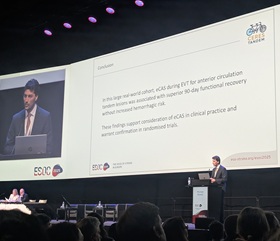
Findings from a real-world cohort of more than 4,000 patients suggest that adding emergent carotid artery stenting (eCAS) to endovascular therapy (EVT) for anterior-circulation tandem lesions represents a safe and effective adjunct in acute stroke care. Data from the CERES-TANDEM study—presented for the first time at the 11th European Stroke Organisation Conference (ESOC; 21–23 May, Helsinki, Finland)—saw eCAS associated with an improvement in 90-day functional outcomes and no increase in symptomatic intracranial haemorrhage (sICH) occurrence.
Tandem lesions—defined as simultaneous high-grade extracranial carotid stenosis or occlusion with intracranial vessel occlusion—occur in up to 20% of large vessel occlusion (LVO) strokes but have generally been excluded from major randomised trials evaluating EVT to date. Researchers believe that optimal management of the extracranial carotid segment during EVT has thus remained uncertain, with observational studies offering mixed signals on clinical benefits versus haemorrhagic risks.
The CERES-TANDEM study is an international, multicentre cohort analysis of consecutive adults treated for anterior-circulation tandem lesions at 49 comprehensive stroke centres across Europe, North America, and Singapore, between 1 January 2018 and 31 December 2024. Of 4,053 patients (median age, 70 years; 65% women), 2,522 underwent eCAS during EVT and 1,531 were treated with EVT alone. Ninety-day modified Rankin scale (mRS) scores were utilised to compare outcomes between the two strategies.
Presented at ESOC 2025 by Michele Romoli (Bufalini Comprehensive Stroke Center, Cesena, Italy), key results from the study showed improvements in functional recovery with stenting; eCAS was associated with 31% higher odds of a one-point shift toward better 90-day mRS scores versus EVT without eCAS (common odds ratio [OR], 1.31; 95% confidence interval [CI], 1.17–1.47; p<0.001).
Romoli also reported a greater rate of functional independence with eCAS, as per a 27% increase in the odds of patients achieving mRS 0–1 (OR, 1.27; 95% CI, 1.08–1.5; p=0.005) as well as a 30% increase in the likelihood of patients achieving mRS 0–2 (OR, 1.3; 95% CI, 1.13–1.51; p<0.001). The presenter further relayed that the robustness and consistency of these findings on functional outcomes were confirmed across estimand-based direct-effect and principal-stratum analyses.
In addition, the researchers observed improved recanalisation success in the study’s eCAS group, indicated by a 90.9% growth in the rate of complete or near-complete recanalisation (thrombolysis in cerebral infarction [TICI] 2b–3) with stenting compared to 75.9% without stenting (OR, 3.09; 95% CI, 2.53–3.77; p<0.001).
Finally, regarding safety-related outcomes, the researchers found that there was no significant increase in the rate of sICH within the eCAS group versus the EVT-only group (OR, 1.21; 95% CI, 0.93–1.56; p=0.15).
“Emergent carotid stenting alongside thrombectomy for tandem‐lesion stroke yielded more complete recanalisation and significantly improved 90-day outcomes,” said Romoli, who led the CERES-TANDEM study alongside Francesco Diana (Vall d’Hebron Research Institute, Barcelona, Spain) and Thanh N Nguyen (Boston Medical Center, Boston, USA). “Crucially, even after adjusting for recanalisation status, stenting remained a strong predictor of better function without increasing symptomatic haemorrhage.”
Based on these data, the researchers posit that CERES-TANDEM provides observational evidence that eCAS during EVT for tandem-lesion stroke enhances functional outcomes without a prohibitive haemorrhagic risk—and that their real-world results “fill a critical knowledge gap” and support adoption of eCAS in these patients, with further validation in prospective trials required moving forward.










